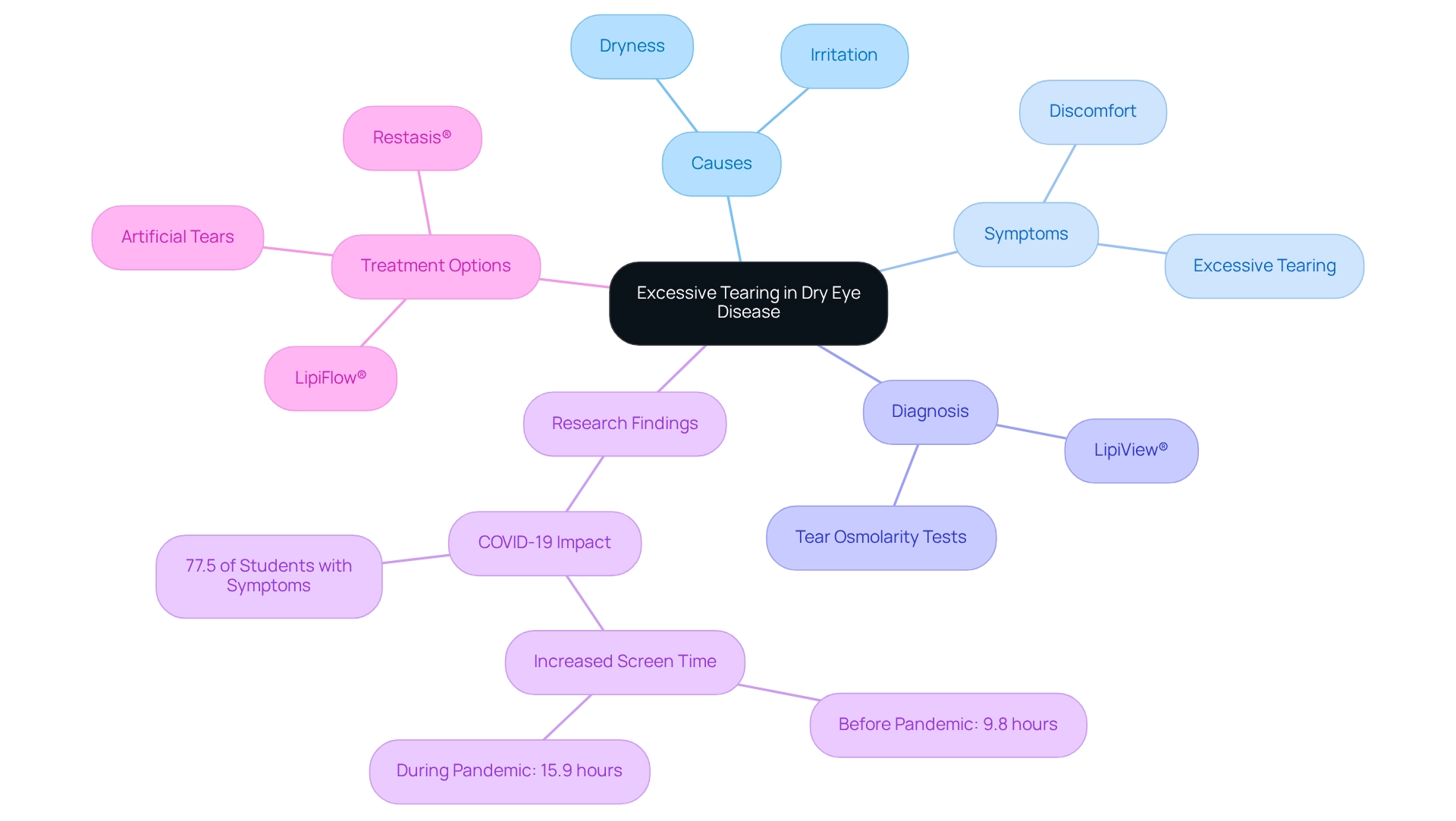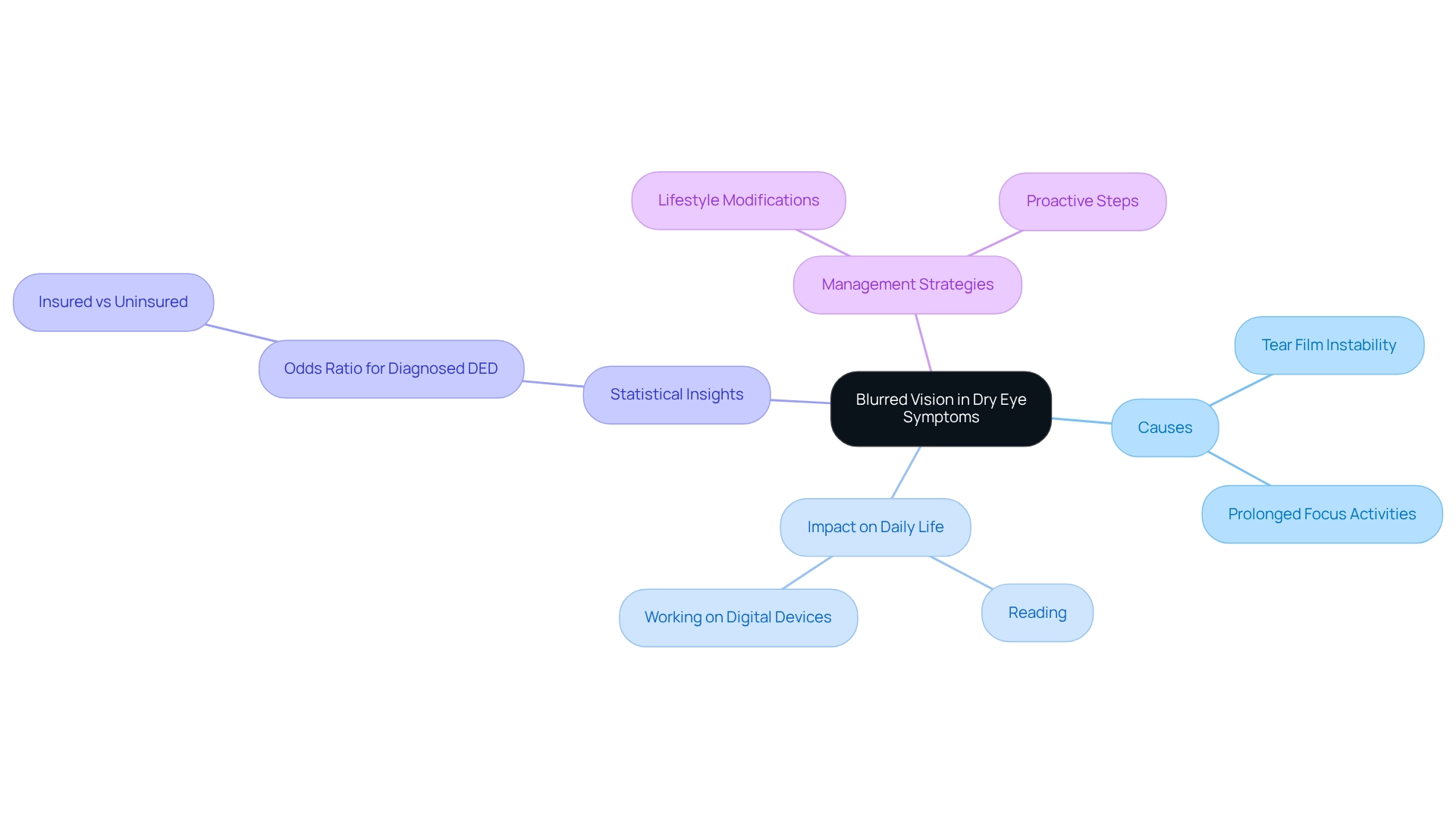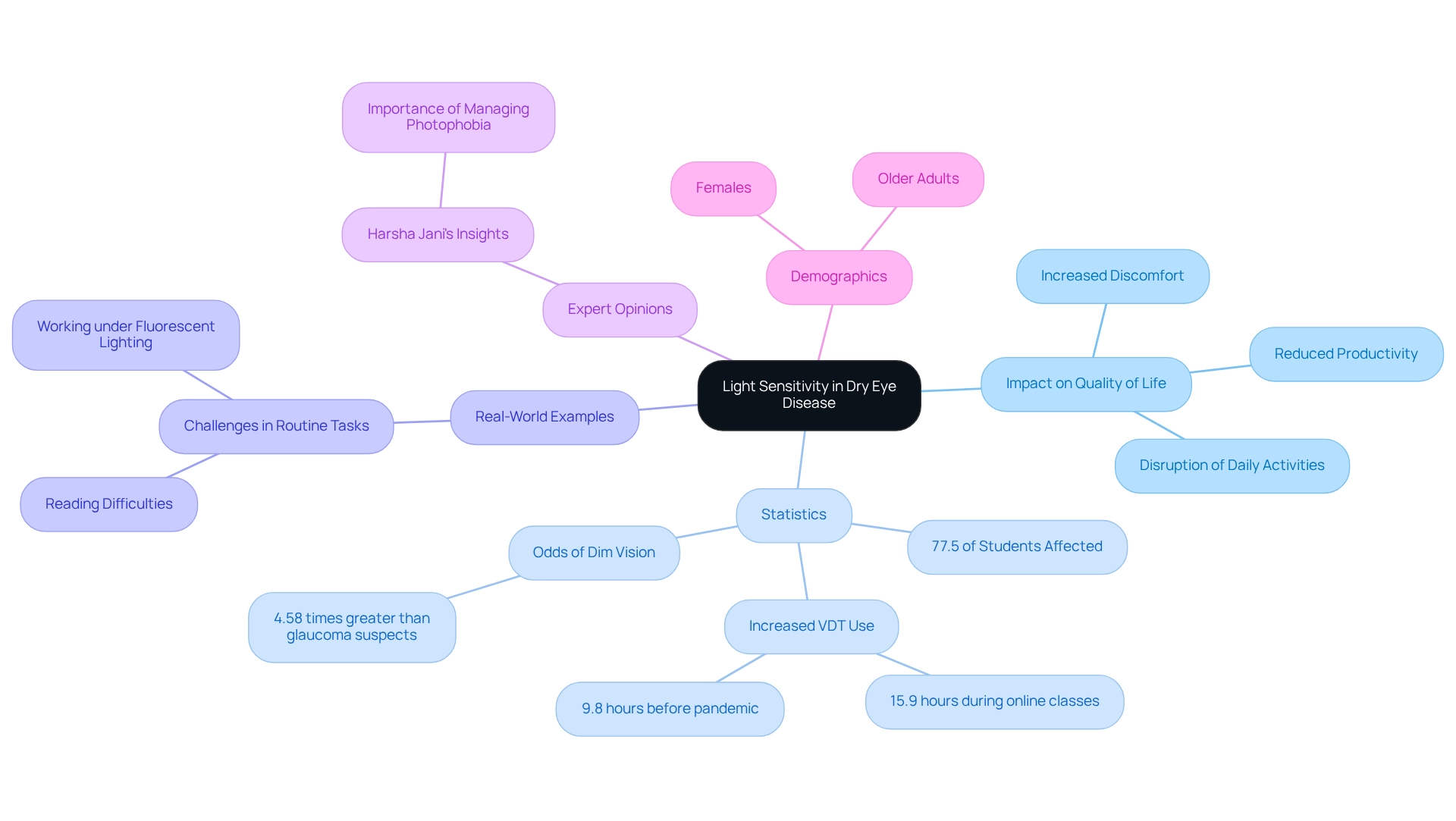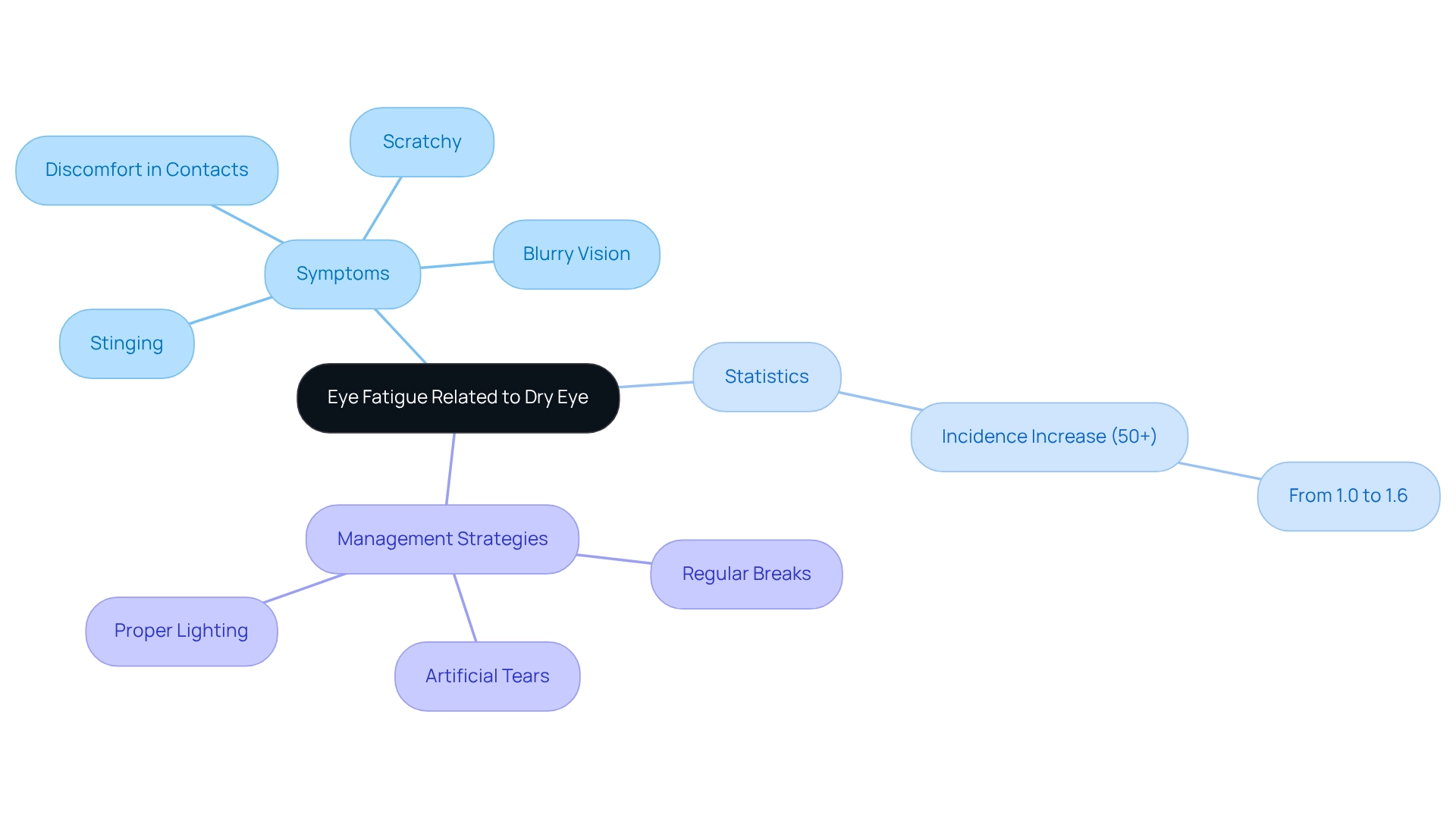Posted by: Northwest Eye in General on May 25, 2025
Overview
This article highlights nine key symptoms of dry eye disease (DED) that you might be experiencing. These include:
- Persistent dryness
- Redness
- Grittiness
- Excessive tearing
- Blurred vision
- Light sensitivity
- Eye fatigue
- Difficulty wearing contact lenses
- The need for professional help
We understand that recognizing these symptoms can be overwhelming, but early identification and seeking expert evaluations can make a significant difference in your journey.
By addressing these symptoms promptly, you can work towards tailored treatment plans that truly improve your quality of life. Recent advancements in diagnostic methods and treatments at Northwest Eye support this approach, emphasizing that you are not alone in managing this condition. Remember, we are here to help you through this process, ensuring that you receive the care and support you deserve.
Introduction
In a world increasingly dominated by screens and digital devices, we understand that many individuals are experiencing the discomfort of dry eye disease. This condition can significantly impact daily life, leading to persistent dryness, eye fatigue, and even surprising symptoms like excessive tearing. It’s common to feel overwhelmed by these challenges, and understanding the nuances of dry eye is crucial for effective management.
This article aims to shed light on the key indicators of dry eye disease. We will explore the latest diagnostic techniques and treatment options available at Northwest Eye, providing you with the reassurance and knowledge needed to take action. By discussing the various symptoms and their implications, we hope to empower you to seek timely professional help and improve your overall eye health. Remember, you are not alone in this journey, and we are here to help you through it.
Northwest Eye: Expert Diagnosis of Dry Eye Symptoms
At Northwest Eye, we understand the concerns you may have regarding . Our specialists employ cutting-edge diagnostic techniques to effectively identify dry eye symptoms, ensuring you receive the best care possible. are complemented by detailed assessments of tear production and quality, allowing us to gain a thorough understanding of your unique condition.
Recent advancements in diagnostic methods, particularly over the past few years, have introduced , specifically designed to confirm dry eye symptoms associated with (DED). These innovations have significantly improved the accuracy of diagnoses, enabling us to create that meet your needs.
Statistics from recent trials indicate that innovative devices, such as the Mibo Thermoflo, have led to among individuals. This underscores the importance of utilizing the and its positive impact on your outcomes.
Furthermore, we believe that empowering you with knowledge about your condition is essential for effective management. By offering resources and guidance, we assist you in navigating your treatment choices, fostering better outcomes. As emphasized by , , and our group is committed to ensuring that you feel well-informed and supported throughout your journey.
Ongoing ophthalmic evaluations also play a crucial role in managing DED. They enable us to continuously assess and modify treatment strategies to address your changing needs. We are here to help you through this process, ensuring that you receive the you deserve.
Persistent Dryness: A Key Indicator of Dry Eye Disease
in the eyes is often the first sign of , and we understand how this relentless sensation can be distressing. Many patients report that their discomfort related to dry eye symptoms remains unrelieved even with over-the-counter artificial tears. This persistent dryness can significantly impact daily activities due to dry eye symptoms, affecting work, leisure, and overall quality of life.
For example, during the COVID-19 pandemic, increased screen time led to a notable rise in dry eye symptoms, with 77.5% of university students reporting ongoing dryness due to prolonged exposure to digital devices. Such statistics highlight the early. Not only do these dry eye symptoms indicate dry eye disease, but they also play a crucial role in assessing the severity of the condition.
The overall yearly expense of ophthalmologist-directed care for 1,000 individuals with dry eye disease is projected at $782,673 in the United States. This figure underscores the and the importance of addressing issues promptly. Experts suggest that acting quickly can prevent further complications and improve outcomes for individuals.
At Northwest Eye, ophthalmologists emphasize that ongoing dryness can hinder focus and efficiency, making it essential for those affected by dry eye symptoms to seek professional assessment and available at the .
At Northwest Eye, we conduct a comprehensive evaluation to determine the severity of dry eye symptoms. Our , such as LipiView® and Tear Osmolarity, are designed to identify the best course of treatment. Innovative options like LipiFlow® and BlephEx® may be included in your care plan.
By understanding the prevalence and implications of persistent dryness, you can take proactive steps to manage your eye health effectively and address dry eye symptoms. of extended screen exposure, such as taking regular breaks and ensuring adequate hydration, can also be beneficial.
Furthermore, research like the Beaver Dam Eye Study adds credibility to the claims regarding the prevalence of , highlighting the need for awareness and action. We are here to help you navigate this journey toward better eye health.
Redness in the Eyes: A Common Dry Eye Symptom
Redness in your vision can often signal , primarily stemming from inflammation of the surface due to insufficient lubrication. This condition may present as bloodshot eyes, which are common dry eye symptoms, especially after long hours in front of screens or in dry environments. Research indicates that individuals spending significant time in air-conditioned settings report an average (OSDI) score of 61.9, reflecting a high level of discomfort associated with dry eye symptoms. This underscores the importance of awareness and proactive management of for those affected.
The connection between and eye redness is gaining attention among eye care professionals. They recognize that can worsen inflammation of the ocular surface. For instance, certain , especially selective serotonin reuptake inhibitors (SSRIs), can worsen dry eye symptoms. This highlights the necessity of in individuals undergoing such treatments, as many may be unaware of how their medications could be worsening their condition.
Inflammation of the eye surface can manifest in various ways, including redness, discomfort, and visual disturbances. Understanding what causes dry eye symptoms is vital for effective management. Factors such as —like air conditioning and low humidity—and lifestyle choices, including screen time habits, contribute to the prevalence of dry eye symptoms, such as redness. By recognizing these signs and their triggers, you can seek to alleviate your discomfort.
As Dominika Wróbel-Dudzińska from the Department of Diagnostics and Microsurgery of Glaucoma emphasizes, being aware of these factors is crucial for maintaining ocular health. To manage dry eye issues effectively, consider adopting a few simple strategies:
- Take regular breaks from screens
- Use artificial tears
- Ensure your environment is well-hydrated and humidified
We are here to help you through this process, and is important to us.

Grittiness or Foreign Body Sensation: Recognizing Dry Eye
Patients suffering from often describe a gritty or sandy sensation in their eyes, similar to having a foreign object lodged within. We understand that this discomfort can be distressing and significantly impact your daily activities. play a vital role in amplifying dry eye symptoms; for instance, exposure to wind, smoke, or dry air can worsen these symptoms, leading to increased irritation and discomfort.
It’s important to note that statistics indicate insured individuals are more likely to be diagnosed with , with an odds ratio of 2.12 compared to their uninsured counterparts. This underscores the significance of having access to , particularly since real-world experiences demonstrate how common environmental triggers can exacerbate dry eye symptoms. Many individuals report or in smoky environments.
The focused method employed by Northwest Eye, highlighted in the case study ‘Addressing Common Eye Health Challenges,’ demonstrates through personalized care strategies. Experts emphasize the importance of consulting your eye care provider if you experience these sensations, as understanding the underlying causes can lead to more effective management strategies.
By addressing these environmental factors and their effects on dry eye symptoms, you can better manage your condition and pursue suitable treatment. If you notice these signs, we encourage you to reach out to your eye care provider for assistance.
Excessive Tearing: An Unexpected Dry Eye Response
can be a surprising yet common symptom associated with for those experiencing dry eye disease. We understand that this paradoxical response occurs when dryness irritates the eyes, prompting the lacrimal glands to overproduce tears. Unfortunately, these tears often lack the necessary components for effective lubrication, leading to further discomfort and irritation.
At Northwest Eye, our specialists recognize that excessive tearing can indicate . We utilize , such as LipiView® and Tear Osmolarity tests, to assess both the quality and volume of tears, ensuring a comprehensive understanding of each patient’s condition.
Research has shown a significant connection between prolonged screen time and the worsening of dry eye issues. For instance, during the COVID-19 pandemic, a study in Chile revealed that 77.5% of university students experienced symptoms of dry eye, as their screen time increased from an average of 9.8 hours to 15.9 hours during online classes. It’s common to feel that excessive visual display terminal (VDT) use can lead to both dryness and paradoxical tearing.
The relationship between dry eye and lacrimal gland overproduction is indeed complex. When the eyes are dry, the body attempts to compensate by generating more tears; however, these tears may to relieve discomfort effectively. This can create a cycle of discomfort where individuals experience dry eye symptoms along with excessive tearing. The overproduction of tears is a response to irritation, but without the right components, these tears fail to provide relief.
Experts in eye care emphasize the importance of a nuanced understanding of this condition. As one specialist at Northwest Eye noted, “Just looking at the percentages without clinical improvement tells me that we need something different.” This highlights the significance of customized treatment methods that address both the underlying dryness and the .
At Northwest Eye, we offer various , including LipiFlow®, Restasis®, and artificial tears. These therapies aim to restore adequate lubrication and relieve symptoms effectively.
In summary, while excessive tearing may seem counterintuitive in the context of dry eye disease, it is a common response to irritation caused by dryness. Understanding this relationship is essential for effective management and treatment of dry eye symptoms. To alleviate strain from excessive screen time, consider taking regular breaks, using artificial tears, and exploring the treatment options available at Northwest Eye to support your eye health.

Blurred Vision: A Serious Dry Eye Symptom
can be a significant concern for those experiencing , often stemming from instability in the tear film, which is crucial for maintaining clear sight. We understand that patients frequently experience fluctuations in their visual acuity, especially during activities that require prolonged focus, such as reading or using digital devices. Research indicates that individuals with commonly report dry eye symptoms, such as blurred vision, with studies showing that the likelihood of encountering this issue is notably higher among those diagnosed with the condition. In fact, the odds ratio for among insured participants is 2.12 compared to their uninsured counterparts, highlighting a concerning trend in prevalence specifically related to blurred vision.
Experts emphasize the seriousness of blurred vision in the context of dry eye symptoms and dry eye disease. Ophthalmologists point out that the can lead to , which affect both daily activities and overall . As one expert stated, “Dry eye symptoms negatively affect physical and mental health as well as vision,” which underscores the multifaceted impact of this condition. A randomized controlled trial focusing on experiencing dry eye symptoms suggested that addressing lifestyle factors could help alleviate issues, including blurred vision, thereby enhancing individuals’ quality of life.
Real-world examples illustrate how fluctuations in vision can affect daily life. For instance, a patient might notice their vision blurring while reading a book or working on a computer, prompting them to blink more often or take breaks to regain clarity. By between tear film instability and vision clarity, individuals can take their dry eye symptoms effectively. Remember, we are here to help you through this process and support you in finding the right solutions.

Light Sensitivity: A Discomforting Dry Eye Symptom
, often referred to as photophobia, is a common and uncomfortable symptom associated with in . We understand that many patients experience pain or overwhelming discomfort in bright environments, which can . This heightened sensitivity is primarily caused by inflammation and irritation of the ocular surface, highlighting the importance of .
Statistics reveal that . For instance, a study found that 77.5% of university students in Chile reported experiencing dry eye symptoms, particularly during increased screen time due to online classes, a trend that has worsened during the COVID-19 pandemic. Furthermore, individuals with dry eyes have notably —4.58 times greater than those suspected of having glaucoma.
Real-world examples shed light on the challenges faced by individuals with photophobia. Many report difficulties in performing routine tasks, such as reading or working under fluorescent lighting, leading to increased discomfort and reduced productivity. Expert opinions emphasize that addressing light sensitivity is essential for enhancing the overall well-being of individuals suffering from dry eye symptoms. Harsha Jani notes, “Effectively managing photophobia can significantly enhance the quality of life for those suffering from dry eye symptoms and dry eye disease.”
Case studies indicate that photophobia tends to be more prevalent among certain demographics, particularly . This reinforces the understanding that aging and gender are . By comprehending the implications of light sensitivity, healthcare providers can better assist individuals in managing this distressing issue and improving their quality of life. We are here to help you through this process.

Eye Fatigue: Recognizing the Impact of Dry Eye
Eye fatigue is a common concern for many individuals experiencing related to dry eye disease (DED). You might describe it as a sensation of heaviness or strain in your eyes, especially after prolonged reading or screen time. can include:
- Stinging or burning sensations
- Scratchy feelings
- Blurry vision
- Discomfort when wearing contact lenses
Research shows that the has increased from 1.0% to 1.6%. This rise highlights the growing prevalence of this condition, particularly among those who may also be at risk for . It’s understandable that these signs can exacerbate feelings of , leading to discomfort and decreased productivity—especially for individuals with cataracts who may already be facing vision challenges.
In a study examining the broader implications of DED, it was found that this condition , impacting both social interactions and work-related functioning. This underscores the importance of addressing dry eye issues not just for comfort but also for overall health, particularly for those dealing with cataracts.
Experts indicate that increased screen time contributes to eye fatigue, with many individuals reporting heightened discomfort during extended digital tasks. Debra A. Schaumberg, a specialist in this field, emphasizes the importance of recognizing how dry eye indicators can influence comfort while using screens. This is especially vital for individuals with cataracts who may rely on digital devices for communication and information, particularly considering the well-established connection between dry eye symptoms and eye strain.
Statistics reveal that a significant number of individuals experiencing dry eye symptoms frequently deal with eye fatigue. Real-world experiences show that individuals with DED often struggle with eye strain and dry eye symptoms, particularly in situations that demand .
To effectively manage dry eye symptoms during cataract treatment, consider strategies such as:
- Taking regular breaks while using screens
- Using artificial tears to maintain moisture
- Ensuring proper lighting when reading or working on digital devices
If you are facing severe symptoms, we encourage you to . They can perform comprehensive evaluations and recommend . By acknowledging the impact of dry eye on visual comfort, you can take proactive steps to seek appropriate treatment and enhance your quality of life.

Difficulty Wearing Contact Lenses: A Sign of Dry Eye
Struggles with wearing contact lenses can often indicate the presence of , which is a concern that individuals with should be particularly aware of. We understand that many patients experience discomfort and irritation, as well as dry eye symptoms, or a persistent feeling of dryness while using lenses, especially those who spend long hours at visual display terminals (VDT). Research shows that working more than four hours increases the likelihood of experiencing dry eye symptoms. It’s important for , including those with cataracts, to communicate these signs to their . By doing so, they can receive personalized recommendations, such as alternative lens options or specific treatments to ease discomfort.
, including antihistamines and antidepressants, have been linked to the , which affect and overall ocular health. Additionally, the use of isotretinoin has been linked to increased meibomian gland atrophy and decreased tear film stability, which can further worsen dry eye symptoms. Understanding these connections can empower eye care professionals to develop .
Addressing these signs not only enhances comfort but also promotes overall eye health, allowing individuals to continue wearing their contact lenses without significant issues. Positive feedback from patients highlights the effectiveness of , underscoring the importance of open communication between patients and their eye care providers. As Jason J. Nichols, OD, MPH, PhD, emphasizes, “This is believed to result from the addition of a mixed classification to the answer choices this year,” reflecting the evolving understanding of dry eye management.
Seek Professional Help: Addressing Dry Eye Symptoms
Encountering can be concerning, and we understand that immediate expert attention is essential. At Northwest Eye, our dedicated team is here to provide and tailored treatment plans designed to meet your unique needs. Early intervention is crucial; studies indicate that and mitigate the risk of complications. Many individuals who interact with our specialists frequently mention enhanced results, emphasizing the value of .
Research underscores the importance of thorough assessments for identifying dry eye symptoms. At Northwest Eye, our evaluations not only identify the underlying causes but also help develop . This proactive approach is essential, especially since . Increased awareness of dry eye symptoms and their associated risk factors can lead to more .
Real-world examples demonstrate the success of our treatment plans. Numerous individuals have benefited from treatments like . While its efficacy can vary, many report symptomatic relief from dry eye symptoms, showcasing the potential of targeted interventions. As Christopher E. Starr from Weill Cornell Medicine notes, “CsA binds to another protein, cyclophilin A, to form a complex molecule modulating immune responses by inhibiting T lymphocyte activity.” This highlights the importance of professional guidance in the management of dry eye symptoms. Additionally, the price of a 30-day supply of topical cyclosporine is roughly $293.45, which may restrict its availability for some individuals. At Northwest Eye, we are committed to empowering our patients with the knowledge and resources necessary for effective dry eye management, including various financing programs and payment plans to make the cost of care easy and manageable.
To take the first step towards , we invite you to consider taking our today. Additionally, remember to stay hydrated and regularly use preservative-free artificial tears to effectively manage dry eye symptoms.
Conclusion
Recognizing and addressing dry eye disease is essential for maintaining eye health and enhancing quality of life. We understand that symptoms like persistent dryness, redness, and excessive tearing can significantly disrupt your daily activities. At Northwest Eye, advanced diagnostic techniques provide a comprehensive understanding of your condition, enabling tailored treatment plans that effectively address these symptoms.
It’s common to feel overwhelmed by lifestyle factors, such as increased screen time, that contribute to dry eye symptoms. As you become more aware of how your habits impact your ocular health, you can take proactive steps to mitigate discomfort. With cutting-edge treatments available, including innovative therapies and patient education, there is hope for effective management of dry eye disease.
Ultimately, seeking professional help as soon as symptoms arise is crucial. Early intervention not only improves your outcomes but also fosters a better understanding of the condition. By empowering you with knowledge and resources, Northwest Eye aims to transform your experience, ensuring you are not alone in your journey towards improved eye health.
Frequently Asked Questions
What diagnostic techniques does Northwest Eye use to identify dry eye symptoms?
Northwest Eye employs cutting-edge diagnostic techniques, including comprehensive eye exams and detailed assessments of tear production and quality, to effectively identify dry eye symptoms.
What are point-of-care tests, and how do they assist in diagnosing dry eye disease?
Point-of-care tests, such as the TearLab osmometer and MMP9 tests, are innovative diagnostic methods designed to confirm dry eye symptoms associated with dry eye disease (DED). They improve the accuracy of diagnoses, enabling tailored treatment plans.
What advancements have been made in the diagnosis of dry eye disease?
Recent advancements include the introduction of innovative devices like the Mibo Thermoflo, which have shown notable improvements in tear break-up time (TBUT), osmolarity, SPEED, and OSDI among individuals, enhancing diagnostic accuracy and treatment outcomes.
Why is it important for patients to understand their dry eye condition?
Empowering patients with knowledge about their condition is essential for effective management. Understanding dry eye symptoms helps in navigating treatment choices and fosters better outcomes.
How do ongoing evaluations contribute to managing dry eye disease?
Ongoing ophthalmic evaluations allow for continuous assessment and modification of treatment strategies to address changing needs, ensuring patients receive compassionate care and support.
What are common symptoms of dry eye disease?
Common symptoms include persistent dryness, discomfort, redness, and visual disturbances, which can significantly impact daily activities and quality of life.
How has the COVID-19 pandemic influenced dry eye symptoms?
Increased screen time during the COVID-19 pandemic has led to a rise in dry eye symptoms, with 77.5% of university students reporting ongoing dryness due to prolonged digital device exposure.
What is the financial impact of dry eye disease on healthcare?
The yearly expense of ophthalmologist-directed care for 1,000 individuals with dry eye disease in the United States is projected at $782,673, highlighting the financial burden of the condition.
What advanced tests does Northwest Eye use to evaluate dry eye severity?
Northwest Eye utilizes advanced diagnostic tests such as LipiView® and Tear Osmolarity to determine the severity of dry eye symptoms and identify the best course of treatment.
What strategies can help manage dry eye symptoms effectively?
Simple strategies include taking regular breaks from screens, using artificial tears, and ensuring the environment is well-hydrated and humidified to mitigate the effects of dry eye symptoms.






